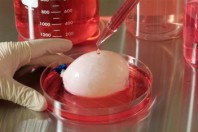Lab-grown organs, ethics, and immortality (1) …

“If a salamander can grow a new arm, why can’t a person?” This is one of the questions asked, some twenty-five years ago, by Anthony Atala and his colleagues who now work at the Wake Forest Institute for Regenerative Medicine. Their question was, of course, a bit of tongue-in-cheek. But they were dead serious about finding ways to treat bladder abnormalities and dysfunction.
In Atala’s field of urology, bladder replacement surgery has long been a major challenge. A standard procedure has been to use a section of intestine to replace the bladder. But this procedure often comes with significant risks, such as tumors, stone formation, and cancer. This is a particular problem with children who have many years left to live. So, Atala asked, “Why not make an organ out of the patient’s own tissue?”
After several years of research and experimentation, his team began a series of bladder replacement surgeries in 1999. Seven volunteers, ages 4 to 19 years, received lab-grown bladders that were produced from cells harvested from their own bodies. Seven years later, Atala and his team were able to report success in the medical journal Lancet.
More recently, an article in The New York Times reported similar progress in lab-grown organs using the patient’s own stem cells. Paolo Macchiarini and his team at the Karolinska Institute in Stockholm, Sweden have produced a wind-pipe that was successfully transplanted to a patient.
Human stem cells are part of the body’s system for building and repairing itself. They begin as a blank slate, but are able to become specialized cells specific to particular tissues or organs like the windpipe. In recent years, scientists have made great advances in understanding how stem cells can differentiate in this way.
[Researchers are also] learning more about what they call scaffolds, compounds that act like mortar to hold cells in their proper place and that also play a major role in how cells are recruited for tissue repair.
The scaffold in the Times article was made of plastic, but there may be other methods that can be developed in the future.
[A]n exact copy of [the patient’s] windpipe was made from a porous, fibrous plastic, which was then seeded with stem cells harvested from his bone marrow. After just a day and a half in a bioreactor — a kind of incubator in which the windpipe was spun, rotisserie-style, in a nutrient solution — the implant was stitched into [the patient], replacing his cancerous windpipe. …
Labs around the world are now experimenting with scaffolds. In some cases the goal is to use the natural scaffolds themselves to build new organs — to take a donor lung, for example, strip all its cells and reseed it with a patient’s own cells. Why not use what nature has perfected, this line of thinking goes, rather than try to replicate it in a synthetic scaffold?
Lab-grown bladders and wind-pipes are firsts-of-their-kind in the developing field of regenerative medicine. Tissue engineering, as the process is called, has also realized success in producing several other types of tissue—skin, blood vessels, esophagus, and muscle. Solid organs are much more difficult to engineer, but researchers are hopeful that someday they can produce lab-grown livers, kidneys, hearts, and pancreas.
These mind-boggling advances in tissue engineering present a number of ethical challenges. But not the ones many people fear—the cloning and destruction of human embryos to secure stem cells. All of these successes come from the use of the patients’ own tissue.
Tomorrow’s post will explore one of the more troubling ethical issues—what is often called “the immortality project.”


 September 24, 2012
September 24, 2012 







Comments are closed.